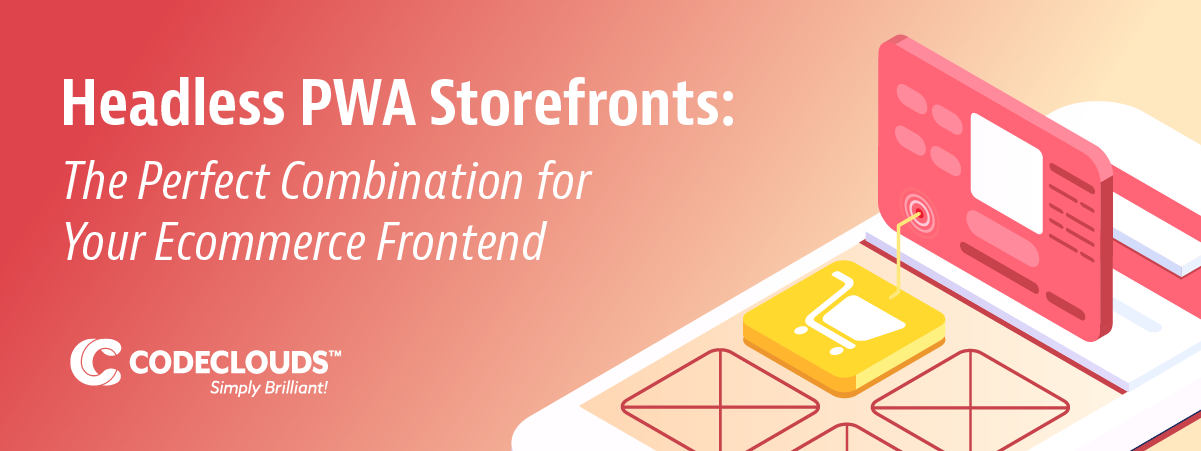Overview
If you want to leverage headless across devices, a headless PWA storefront is the thing for you. You can experience the best of PWAs and headless with increased User Experience and easy customization and integration. Let us explain why you should consider a PWA storefront for your eCommerce frontend:

What Is a PWA?
Basically, a Progressive Web App is a web app that acts like a native mobile app. It can be used offline and linked to your phone’s homepage. PWAs are also super fast, don’t need to be downloaded, and can send push notifications.
How Does a PWA Go Headless?
Headless commerce is where the frontend and backend of your eCommerce site are disconnected (or even split up completely into microservices) and then reconnected via an API orchestration layer. Headless offers advanced flexibility as it frees you from having to code the backend.
Headless storefronts can be created with a range of technologies, including PWA. Let’s look at how this combination of technologies can help you:
Why You Should Try Headless PWA for Your Ecommerce Frontend
Headless and PWAs are a great combo, one of the best solutions for your mobile eCommerce storefront. Why? Here are some of the most compelling reasons to implement a PWA storefront:
Best Mobile UX:
Headless PWAs provide the highest quality mobile UX. This is because PWAs allow you to optimize your site for different screen sizes, act like a mobile app (without needing to be downloaded), can be used offline, and they’re fast. Headless just adds to this, by providing extra customization and speed. Talking of speed…
Headless PWA Is Fast:
Both headless and PWAs help speed up your site because PWA technology and the APIs that headless run on cache less data. They also tend to be slimmer than monolithic solutions and native mobile apps, which is great for mobile speed.
Improved SEO:
Your headless PWA’s speed is sure to impress Google’s Core Web Vitals and other SEO indicators. Not to mention, PWAs, unlike native mobile apps, are searchable. In a competitive mobile market with poor mobile conversion rates, this can really get you ahead.
Customization:
If you go for a headless PWA instead of just a PWA for your eCommerce frontend, you have far more room to customize your site. As you’re no longer dependent on monolithic programs and the backend, you can easily change themes, and you can even change your mobile storefront without changing your desktop website. The same benefit makes updates easily.
Personalization:
PWA technology makes it easy for customers to personalize their experience (e.g. opting out of certain notifications). So does headless, which simplifies running automation and third-party apps such as live chat.
Microservices and Integrations:
Using headless technology, you can easily integrate microservices and third-party apps into your PWA, improving your customer experience even more (and, as mentioned above, opening up opportunities for personalization).
Cross-Platform Uses:
Headless development has the advantage of being able to create the same interface for different platforms (because you don't have to worry about the backend). PWA builds on this, as the same PWA (unlike a native app) can be used across Windows, Mac, iOS, and Android. With headless, it can even be used on IoT devices.
Quicker Time To Market:
PWAs are quicker to make than a native mobile app. The same applies for creating a headless frontend versus creating an entire custom website from scratch. This quicker time to market will save you money on dev costs and allow you to make updates sustainably.
Better ROI:
The cumulative effect of all of these improvements is that headless PWAs will increase your ROI. Companies that have implemented PWAs show significant increases in conversions through better UX and higher levels of engagement. Headless also increases ROI by saving you money in development costs in the long run.
Modern Tech Stack:
Headless PWAs allow your developers to use modern tech stacks like React and Vue.js. Many headless programmes also give you significantly more choice or even complete freedom as to which languages you work in.
Future-Proofing:
On the topic of modern, headless PWAs are completely up-to-date technology that you want to take advantage of in order to future-proof your eCommerce store. Implementing a headless PWA storefront will help you weather changes in the mobile eCommerce market.
But Aren’t Headless PWAs Expensive?
But what if you can’t afford to code a headless PWA storefront from scratch? After all, a headless PWA isn’t like a normal PWA that CMS providers like Magento can help you create from your website. Fortunately, you have options:
Use a FEaaS Plaftorm:
Some Frontend as a Service (FEaaS) platforms allow you to create a headless eCommerce storefront as a PWA from a series of pre-optimized, pretested, blocks. While this isn’t quite a no-code solution, it’s a whole lot less coding than building a headless PWA storefront from scratch.
Hire an Offshore Development Team:
Another solution, which is less expensive than you’d expect, is hiring an offshore development team, like Codeclouds. Your own dedicated offshore development team can build you a custom PWA storefront without the costs that you’d expect from hiring people in-house or contracting an onshore development team.

Headless PWA storefronts are the tech you should consider to optimize your mobile user experience. With the customization and flexibility of headless and the advanced mobile optimization of PWAs, you can’t go wrong.
Share this article
147 reads
Similar Reads








